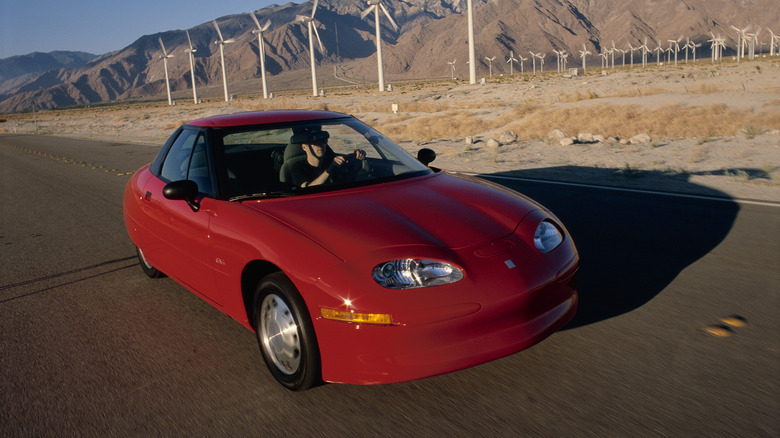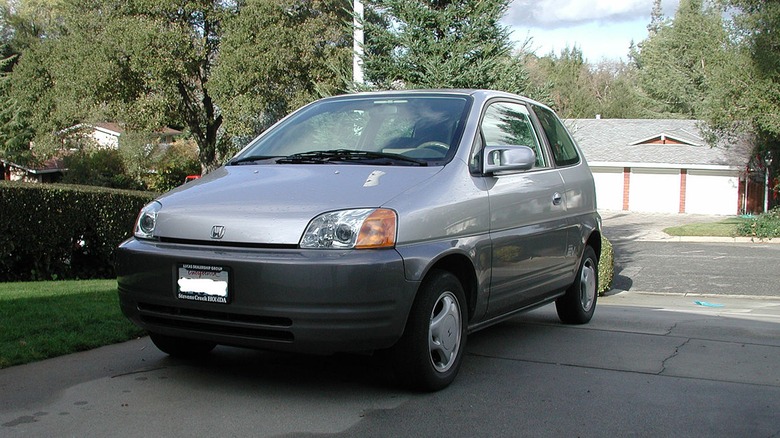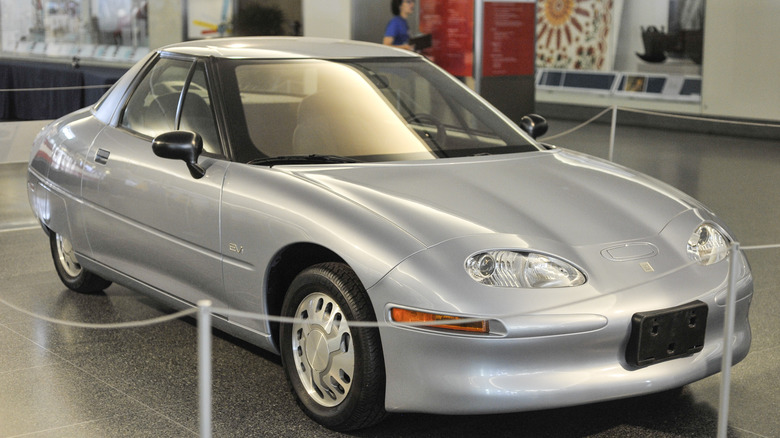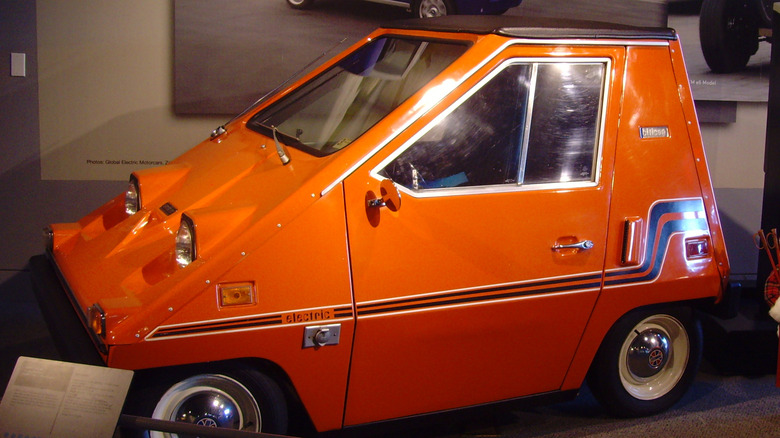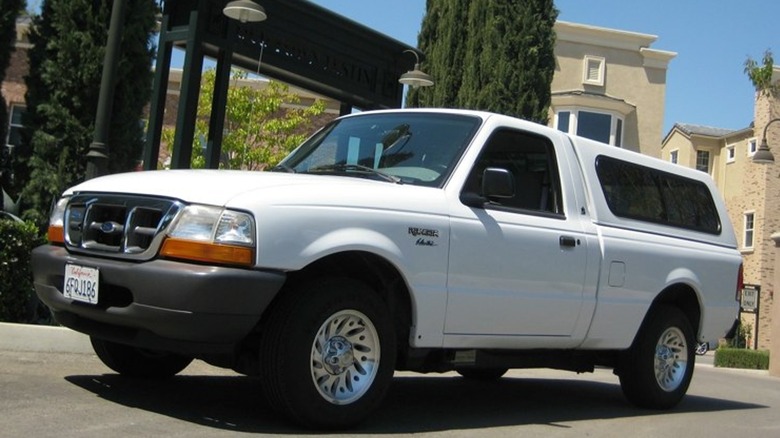5 Classic EVs You've Probably Never Heard Of
When thinking of electric cars, Tesla is likely the first brand that comes to mind. But long before Musk's overhaul of the EV industry, many companies had a stab at building EVs. Many were unsuccessful due to financial or logistical constraints at the time and went on to be demolished. But some left a significant mark in the EV industry, acting as a source of inspiration for the models we see today.
The reasons why companies were pushing out electric vehicles as early as the '90s weren't solely experimental. Environmental concerns were growing, and several regulations were instituted to combat the issue of air pollution. A significant example was the Zero-Emission Vehicle (ZEV) program set forth by the California Air Resources Board in 1990. The program required 5% of vehicles to be zero-emission vehicles in 2001, raising it to 10% in 2003. This, among other incoming restrictions, pushed automakers to start including electric cars in their product line.
While they may not offer the game-changing features that make Tesla models stand out, these classic EVs own a worthy place in the history of electric cars, reshaping the industry and carving the way for future models. With most models destroyed, some of these vehicles are harder to trace and can easily be forgotten. Let's look at five classic EVs you may not have heard of.
Honda EV Plus
While many of Honda's most impressive electric cars have been produced in the last decade, you may not know that the auto giant produced an EV as early as the late '90s. The Honda EV Plus was its first step into the EV industry, and although it was never mass-produced, the vehicle was an impressive feat for its time.
The vehicle ditched lead-acid batteries in favor of cleaner nickel-metal hydride (Ni-MH) batteries in response to tighter emissions rules developing in North America. Research began in 1988, led by Junichi Araki, head of Honda's first-generation EV research team. After 80,000 miles during two years' worth of test drives, the first successful prototype was completed in 1995. One year later, Nobuhiko Kawamoto, the president of Honda at the time, gave the EV Plus a test drive, saying "It's a 'go.'"
The Honda EV Plus officially arrived in 1997; however, it was short-lived and didn't quite pan out as anticipated. Rather than mass-producing the model, Honda made a mere 340 example builds, only to destroy them before the turn of the millennium. On top of that, the example models couldn't be bought outright — they had to be leased for a then-expensive price of $455 per month. The Honda EV Plus made a strong dent in EV history and went on to inspire its newer models today.
[Featured image by Evplus via Wikimedia Commons | Cropped and scaled | Public Domain]
GM EV1
At the same time as the Honda EV Plus, General Motors was also dabbling with EVs trying to reshape the industry. The GM EV1 was an electric vehicle from the late '90s, with a total of 1,117 models built. The classic EV featured some quite impressive specs, including magnesium-alloy wheels and a top speed of 183.8 mph (on a prototype without a speed limiter).
Among its nifty specs, the most influential of them was its battery. The GM EV1 featured a nickel-metal hydride battery, produced by a company that GM owned, which is used in hybrid cars today. A full charge was shown to go up to 100 miles in the first models, before extending it to between 120 and 140 miles after a better battery was developed.
On January 4, 1998, the GM EV1 debuted at the North American International Auto Show in Detroit. But much like the Honda EV Plus, its success was short-lived. The company lost money on every model made, and as a result, General Motors crushed and bricked all but a few of the electric vehicles, leaving only a handful for display at museums and universities.
CitiCar and Comuta-Car
Owning up to its name, the CitiCar and Comuta-Car were two closely related generations of buggy-style EVs, designed for urban residents looking for a faster way to get about the city. Unlike the aforementioned classic EVs, the Comuta-Car was a relative success in the EV industry, taking ownership of the most-sold electric vehicle in the U.S. before the Tesla Model S struck the market decades later.
The CitiCar was the earlier generation of the two cars and was built from 1974 to 1977 by Florida-based company Sebring-Vanguard, with approximately 2,000 models being made. Priced at $3,000, the cars were surprisingly affordable in contrast with their competition. With a short mileage range of 40 miles and a top speed of 40 mph, the cars weren't exactly designed to be top-thrill dragsters. But that didn't stop them from becoming fan favorites. In the mid-seventies, Sebring-Vanguard became the sixth-largest automobile maker in the U.S. Despite its popularity, the CitiCar was eventually discontinued due to safety concerns.
The toy-like EV also made a brief appearance in the '80s but under the Comuta-Car name. In 1979, Sebring-Vanguard was bought by Commuter Vehicles Inc., and the mini vehicle was given its new name. The EV shared a similar speed and range to its predecessor and was also made partially in response to the oil crisis of the 1970s. Unfortunately, after the company ran into financial troubles associated with manufacturing and insurance costs, the Comuta-Car saw its death in the early '80s.
[Featured image by Klaus Nahr via Wikimedia Commons | Cropped and scaled | CC BY-SA 2.0]
Ford Ranger EV (1998)
Avid auto enthusiasts may know that a new Ford Ranger electric pickup is on its way for 2025, following the success of its F-150 Lightning pickup truck a few years prior. But this isn't the company's first shot at producing an electric pickup truck. The 1998 Ford Ranger EV saw a four-year lifespan and rivaled the electric Chevrolet S-10 from General Motors that was only produced in 1997 and 1998.
The classic Ford Ranger EV came in two models based on its battery, the 1999 Ni-MH model and the 1998 lead-acid model, both of which met different performance standards. The lead-acid models were powered by 39 Delphi 8-volt lead-acid batteries, while the Ni-MH Ranger featured 25 Panasonic 12-volt batteries, allowing for an increased payload and a slight decrease in weight. The 1999 Ni-MH battery model also offered a slightly higher range of 82 miles compared to the lead-acid's 65-mile range.
Reports estimate that between 1,500 and 1,700 models were made during the Ranger EV's lifespan. But even after 20 years since Ford stopped producing the electric ranger, a vibrant community of classic EV-lovers still exists today. REVolt is an online group dedicated to the preservation of the original Ford Ranger EV, including literature and technical help. The original Ford Ranger EV is a great example of how electric pickup trucks aren't a new invention.
Chrysler TEVan
Chrysler is another company that's flourishing in recent EV advancements, with the company intending "a full lineup of innovative, seamlessly-connected electric vehicles by 2028." But like other major players in the auto industry, electric vehicles aren't something new for the company. Founders of the Electric Carriage & Wagon Company, which would eventually merge with Chrysler, were responsible for creating the Electrobat, one of the earliest EVs that shaped the industry.
After some failed experiments in the decades prior, the TEVan production phase started in 1993. The electric van delivered a top output of 70 horsepower and featured a range of up to 50 miles on nickel-cadmium batteries or 60 miles with a nickel-iron battery pack. However, there is a good reason you've likely never heard of the Chrysler TEVan — only 80 models were sold according to the company's records, and the EV was only available to electric utility companies, not the general public. On top of this, the EV cost $120,000 per unit, not exactly a customer-friendly price.
Like many of the electric vehicles that came from the '90s, the Chrysler TEVan was short-lived and ceased production in 1995. Though the majority of the vehicles were demolished, there are reports that a few remain, but only under private ownership.
